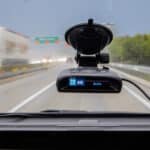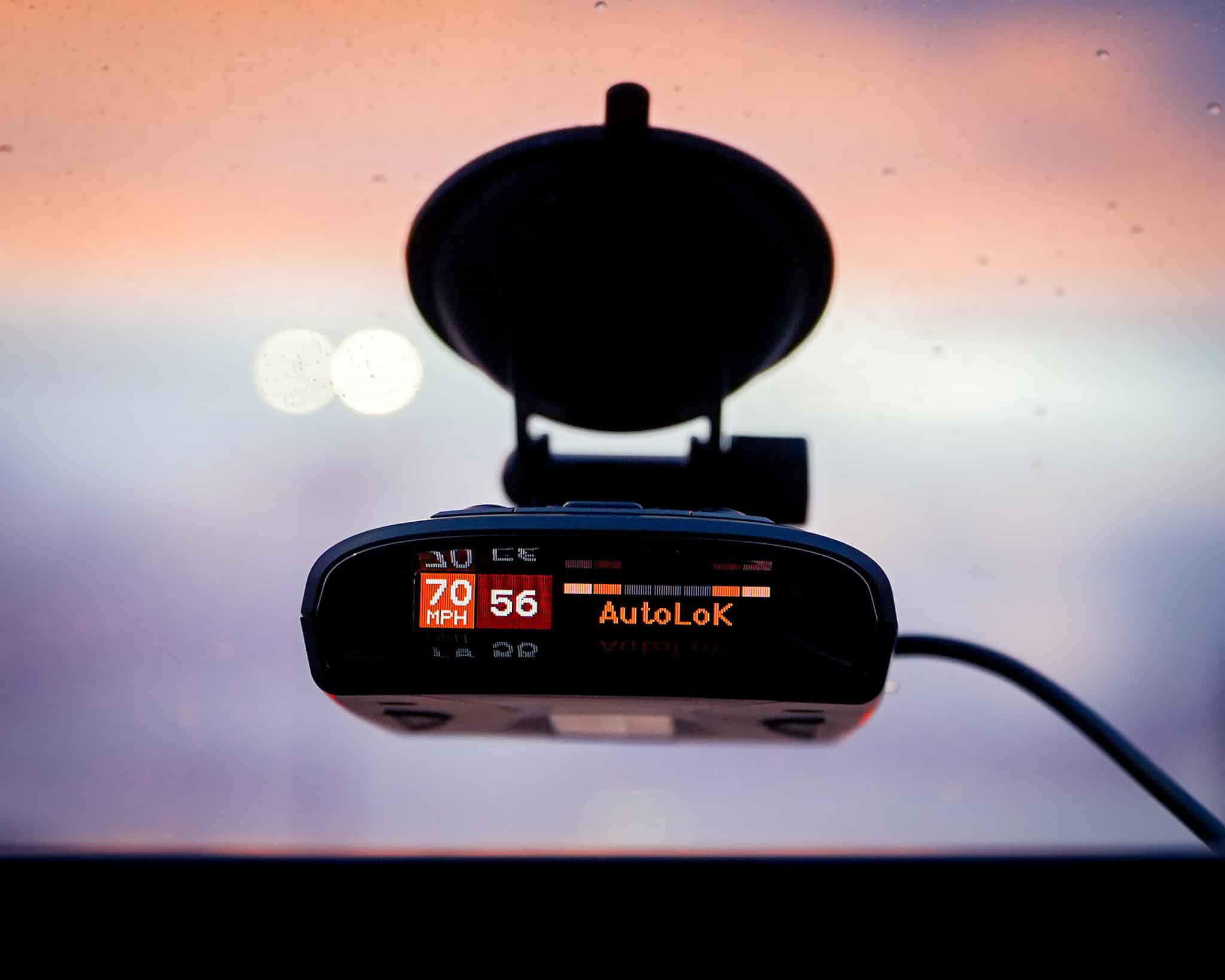Affiliate Disclosure: As an Amazon Associate, Automoblog earns from qualifying purchases. The Escort MAX 4 here was supplied by Cedar Electronics, an affiliate partner. Commissions from Amazon and other affiliate partners come to us at no cost to you when making a purchase via this page. See our Privacy Policy to learn more.
Escort MAX 4 Crash Course
- The MAX 4 is the successor to the Escort MAX 3 radar detector.
- Two Low Noise Amplifiers and a dual-core processor boost the detection range and filtering capabilities of the Escort MAX 4 compared to the MAX 3.
- Escort’s AutoLearn Intelligence automatically locks out fixed-location false alerts along your daily route.
- Drive Smarter app provides increased reaction time against radar and laser threats via crowdsourced notifications.
- Overall, the Escort MAX 4 is a good option if you need an affordable radar detector to help you avoid a speeding ticket.
Our Review Process for Radar Detectors
Automoblog is a member of the Radar Detector and Countermeasures Forum to ensure truth and accountability when covering radar detectors. The Forum has members with years of experience testing and validating radar detectors. Those members can provide additional context and insight if you have more in-depth questions about a specific radar detector.
Whether we receive a radar detector from a manufacturer to review or purchase it with our own money, we consider four main points. Hit the “show more” arrow to see these points. Our primary driving areas with any new radar detector include the Detroit metro and the Ohio Turnpike.
Escort MAX 4 Review: Quick Summary
The MAX 4 is the entry-level unit in Escort’s MAX family of radar detectors, occupying the space once held by the MAX 3. Although the MAX 3 is still available (and for a reduced price on Escort’s website), the MAX 4 outpaces its older stablemate and punches above what its $400 retail price would indicate in terms of range and false alert filtering.
Noteworthy Features
Key features of the Escort MAX 4 include two Low Noise Amplifiers (LNAs), a dual-core processor, an IVT filter, and a multi-color OLED display.
The MAX 4 is compatible with the Driver Smarter app, which sends user-generated police radar alerts to your phone for advanced warnings (more on the app below, including its compatibility with Mapbox, Apple CarPlay, and Android Auto).
The Escort MAX 4 has a single, front-facing antenna, which differs from other higher-tier radar detectors that utilize a dual-antenna design. Directional arrows, which illuminate on the display, are among the primary benefits of a dual-antenna radar detector. Radar detectors with directional arrows (aka directional alert arrows) provide more situational awareness as you can confirm whether the radar source is ahead of or behind you.
By contrast, radar detectors with a single, front-facing antenna, like the Escort MAX 4, can still detect police radar but cannot decipher which direction it’s coming from.
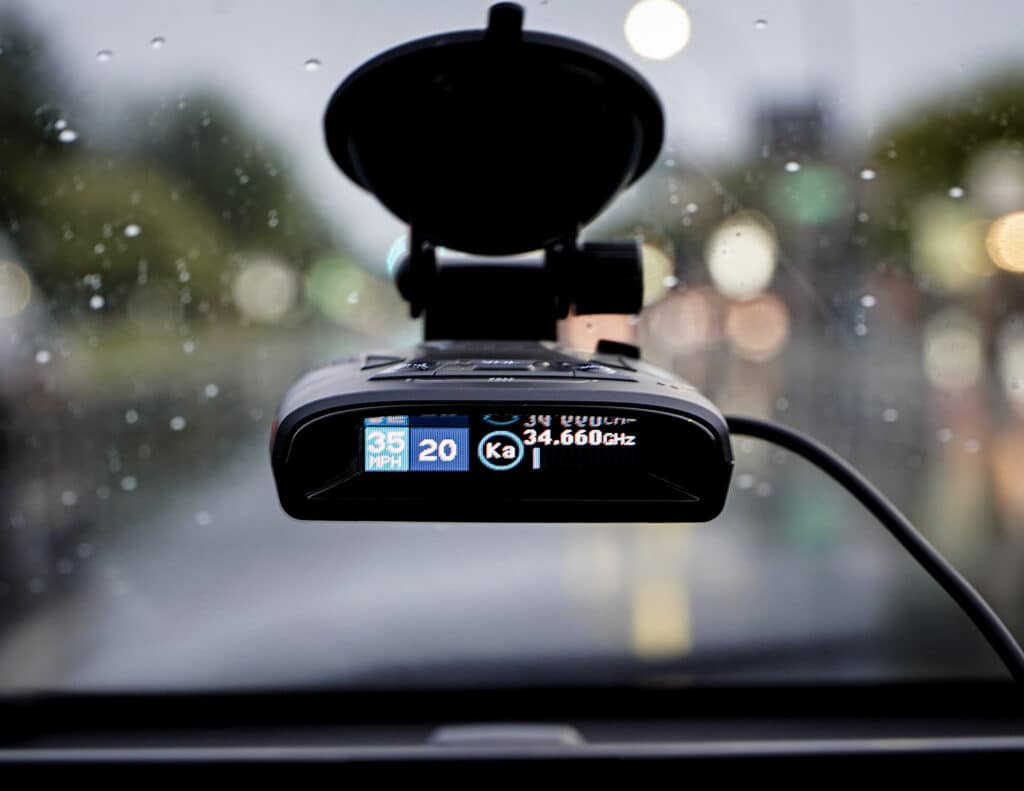
Affordable, Not Cheap
Based on our experience, the Escort MAX 4 is a good option if you are looking to purchase your first radar detector or if you want to upgrade from something older but don’t want to spend too much.
Its affordability is a far cry from cheap, as the MAX 4 offers a dose of the latest tech to be functional and practical for your daily drive without having to dip too far into your bank account.
What We Will Cover
Our focus here is to go through the Escort MAX 4 to help you decide if it’s the right radar detector for you. We will look “under the hood” of the unit, highlight the main features, and walk through the settings menu. Along the way, we will share our experience using the MAX 4 around Detroit and on an extended road trip to Cincinnati.
We will begin with a quick but comprehensive overview of Escort radar detectors, which will give you an idea of how they design their products, including the MAX 4.
Escort Radar Detectors: Focus On The “Falses”
As a brand and manufacturer of radar detectors, Escort has made its name on its ability to filter out “the noise” of your daily drive. While no radar detector, including an Escort detector, is immune to false alerts, Escort makes a considerable and concentrated effort to keep false alerts to a minimum.
Radar-Based Safety Systems
Among the challenges for radar detector manufacturers today is the sheer number of radar frequencies in any given area. Automatic doors are still a thorn in the side, and if you have owned a radar detector in the past 20 years, you can attest to that.
In addition to the local shopping plaza, radar detector manufacturers must contend with an increasing number of late-model vehicles on the road today with safety systems that leverage radar sensing. These systems can include but are not limited to, collision avoidance systems, blind-spot monitors, and hands-free systems like Ford BlueCruise and GM’s Super Cruise.
Adding to that challenge is how, unlike a set of stationary automatic doors, all of these late-model vehicles with their radar-inspired safety systems are moving about. The theory is that without proper filtering (aka false alert filtering), a radar detector would constantly alert as you drive in traffic. If that were the case, how long would it be before you take the detector down from your windshield, and would you ever be inclined to purchase another one?
Alert, Not Annoy
When designing its MAX family of radar detectors, Escort worked under the mindset that consumers need to be alerted, not annoyed, by a radar detector.
Escort’s engineering and development teams recall their own stories of how, long before working for Escort, they purchased a radar detector on a whim, only to “throw it back in the box” because the false alerts and constant beeping were intolerable.
As we move up in Escort’s MAX family, the level of false alert filtering becomes more pronounced. For example, the MAX 360 MKII and MAX 360c MKII use the Blackfin DSP (digital signal processing) chip from Analog Devices, which makes them two of the quietest radar detectors today. The Blackfin is a key feature in other high-end Escort offerings, like the MAXcam 360c and Redline 360c.
Essentially, the higher you go in Escort’s product lineup, the greater the degree of false alert filtering.
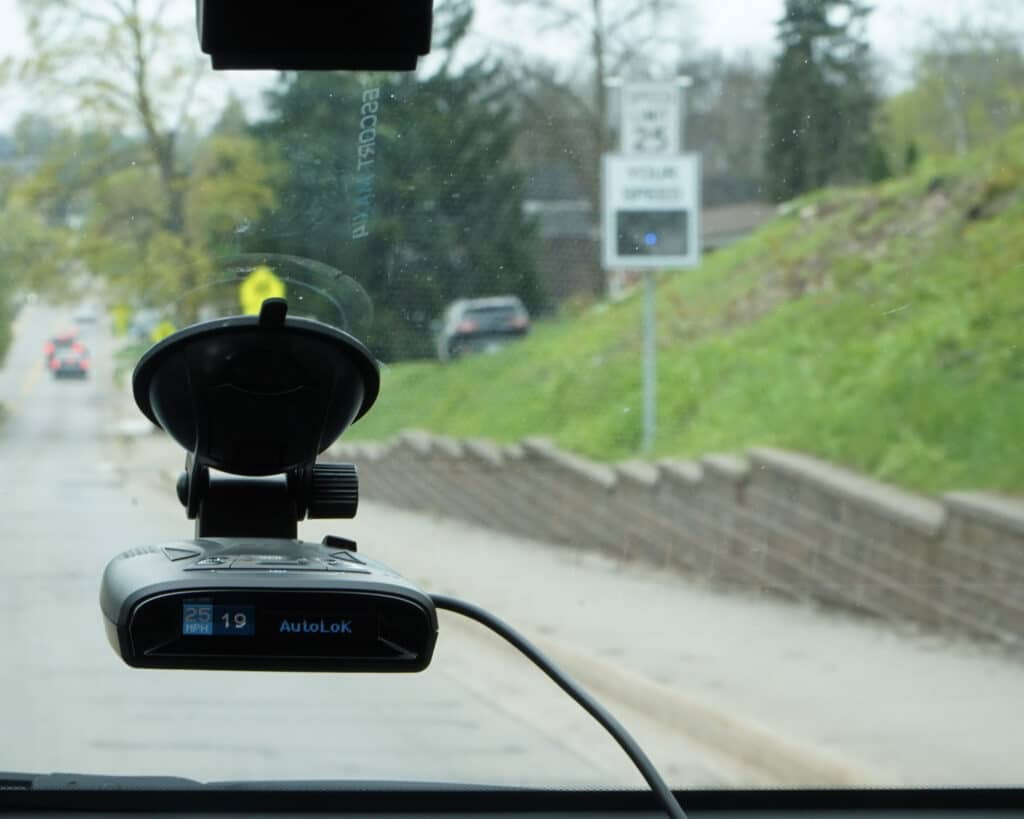
Escort MAX 4 In-Depth: What It Offers
The MAX 4 comes with a 12V power cord, a suction cup windshield mount (called an “EZ Mag Mount”), a carrying case, and a quick start guide (you can download the complete owner’s manual from Escort’s website).
The 12V power cord has a USB port on the backside, so you can still charge your phone. It’s a nice feature if your vehicle doesn’t have a wireless charging pad.
Low Noise Amplifiers (LNAs) & Dual-Core Processor
The MAX 4 has two Low Noise Amplifiers (LNAs) and a dual-core processor, complementary features regarding range detection and false alert filtering.
As explained in this peer-reviewed journal article from Science Direct, the LNA will boost the received signal (radar in the case of the Escort MAX 4) to a sufficient level above the noise floor so it can be used for additional processing (handled by the dual-core processor in this instance).
Signal-to-Noise Ratio
One way to think of the LNAs of the Escort MAX 4 is to imagine we are recording an interview in a room with a lot of additional background noise. There might be an event happening with lots of people, or we could be outside with ambient noise of wind or cars passing by.
Once we have that audio recording, we will want to apply some post-production, say with a program like Adobe Audition. Ideally, we want to minimize the background noise to draw more attention to the person we interviewed. This is a basic way to think of signal-to-noise ratio, whereas the audio of the person is more important than the background noise.
Only Boost What Is Desirable
Taking that a step further, if we “boost” the audio level of the person we have just interviewed in post-production, all of the background noise is simultaneously boosted.
To eliminate or reduce that undesirable background noise and amplify just the audio of the person we are interviewing, we would need to apply noise reduction filters through a program like Adobe Audition. Eventually, the background noise would be cut (or strongly reduced), allowing the interview audio to come through more cleanly.
It’s a similar concept here with the Escort MAX 4. When the MAX 4 detects a radar signal, the LNAs amplify it above the background noise so it’s intelligible enough for the dual-core processor to analyze. The dual-core processor determines if that radar source is false or legitimate, and if it’s the latter, relays that information to the display screen to alert you.
If you have the MAX 4 set to “Spec” in the settings menu, you will see the radar band type, signal strength, and numeric frequency.
Range Detection & False Alert Filtering
LNAs are a feature in other affordable but high-performing radar detectors, like the Uniden R4, arguably the MAX 4’s biggest competitor.
Like the age-old Ford and Chevy debate, radar detector enthusiasts will have much to discuss when comparing the merits of the Uniden R4 and Escort MAX 4. While our official position is that they are both great radar detectors, one thing is for sure: the MAX 4, with its twin LNAs and dual-core processor, has better detection range and false alert filtering than the MAX 3.
Our evaluation of the MAX 4 consisted of a late afternoon drive down I-75 from Detroit to Cincinnati. A few areas along the way, mostly road construction zones in and around Dayton, Ohio, caused some temporary and fleeting false K band alerts. Otherwise, through Cincinnati and around Detroit, and for most of the drive down I-75 and back home, the MAX 4 was quiet in the Auto Lo K sensitivity mode.
Coming back home from Cincinnati, the Michigan State Police were patrolling heavily just past Toledo, particularly the stretch of I-75 between Monroe and Flat Rock, Michigan. On two occasions, the Drive Smarter app (covered further below) provided us with user-generated warnings as far as 4,000 feet away (roughly 0.75 miles). The MAX 4 would alert shortly thereafter, usually from about a half mile out.
The longest detection range we observed was 0.9 miles on Jefferson Avenue, heading into Detroit from Grosse Pointe. Stopped at the intersection of Walker Street and Jefferson Avenue, the MAX 4 alerted to a 34.7 GHz Ka band. We continued to follow the signal until we passed a Detroit Police car that had stopped another vehicle in front of the Meijer Rivertown Market.
The screenshots below from Google Maps show our approximate location at the intersection of Jefferson Avenue and Walker Street and the location of the Meijer Rivertown Market, where the Detroit Police stopped a motorist.
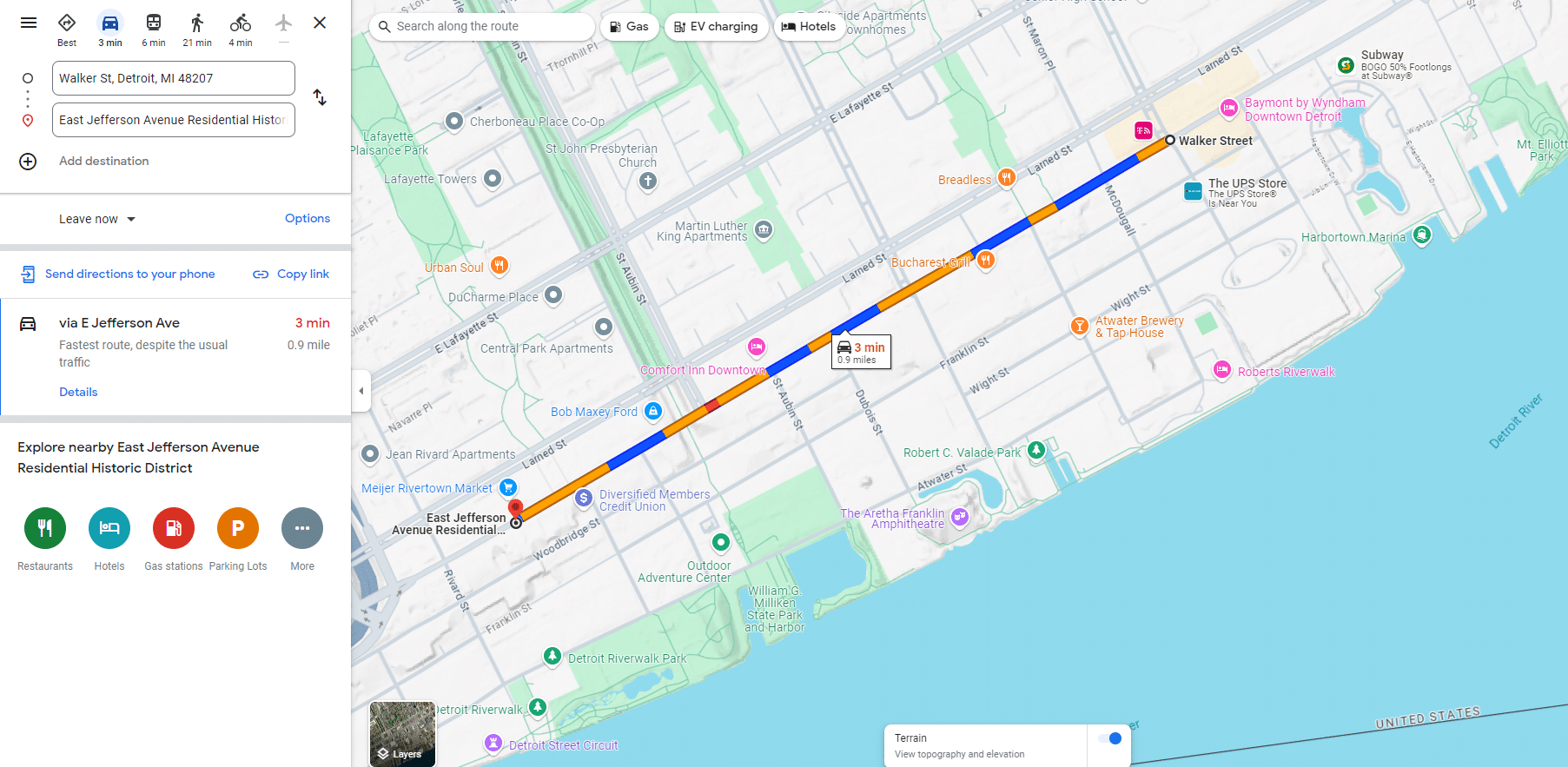
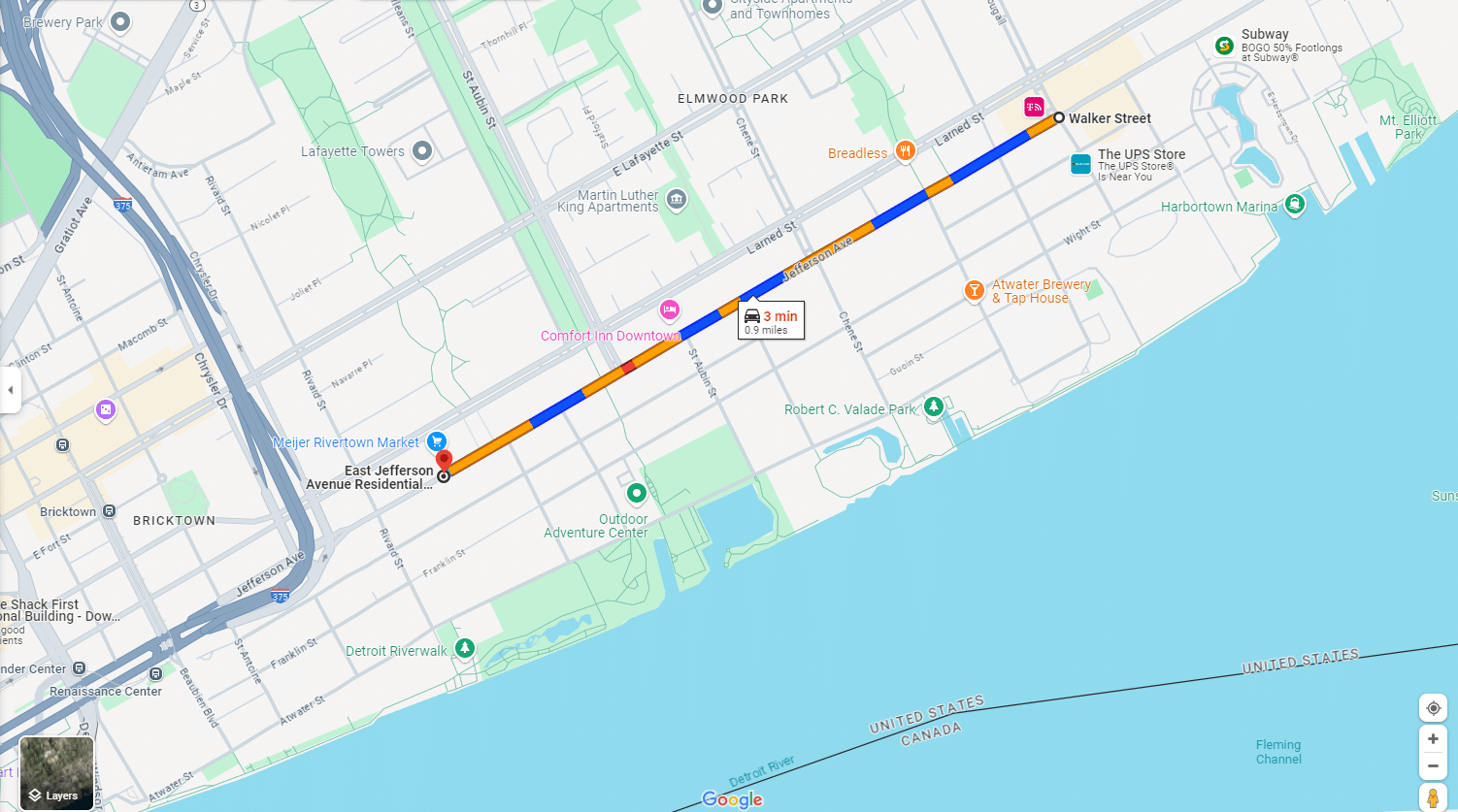
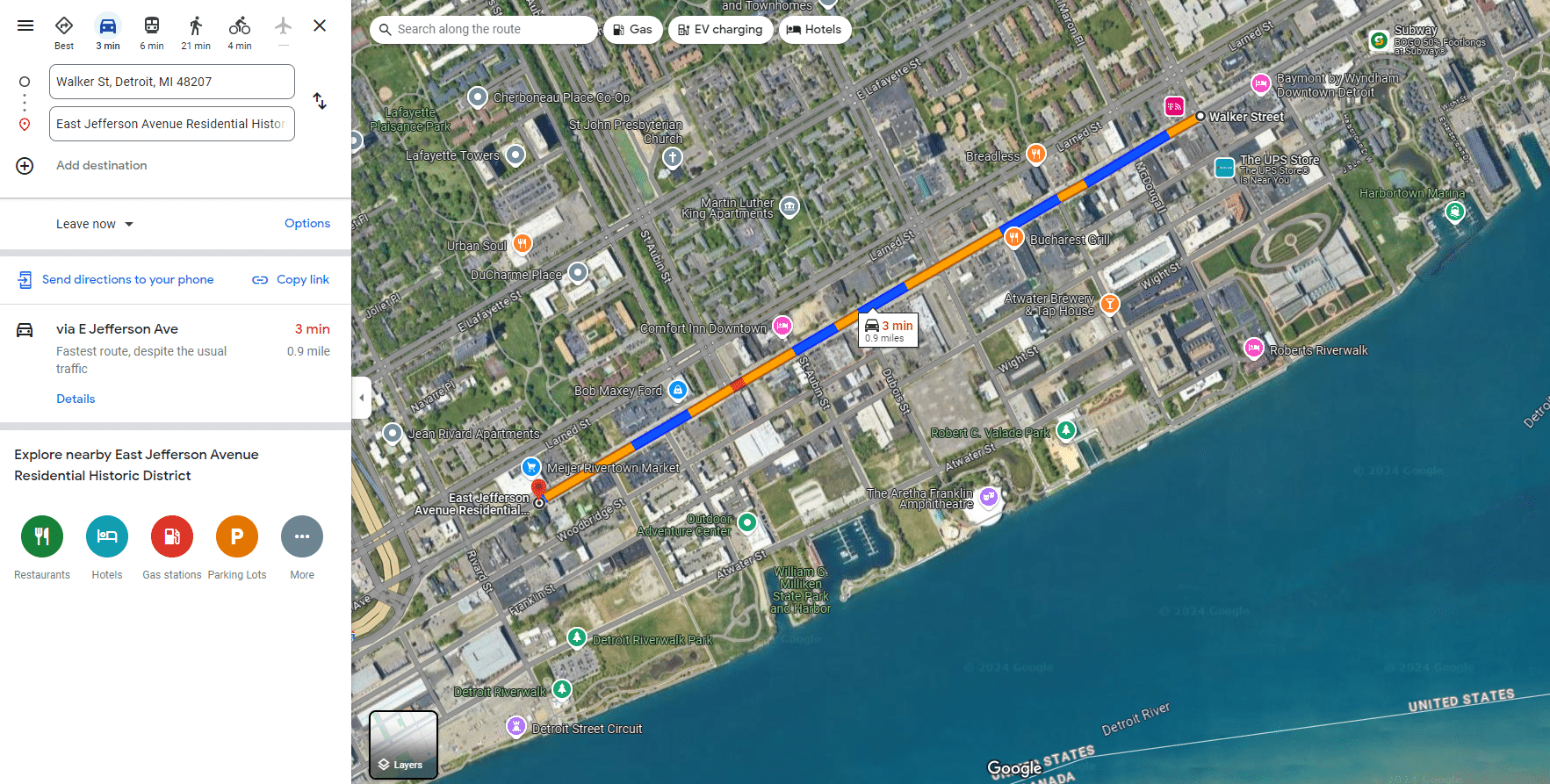
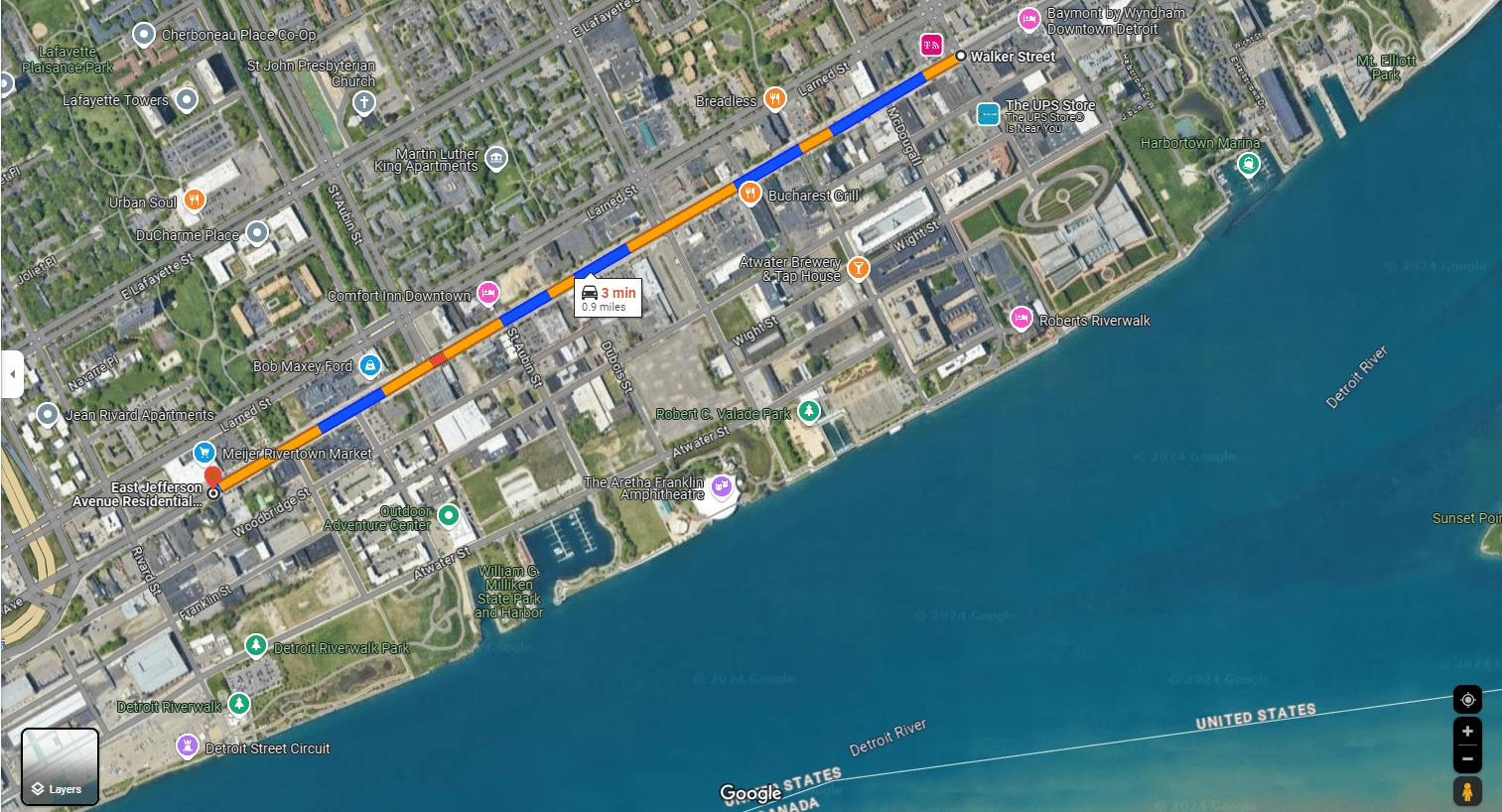
Band Detection: Ka, lidar, Mesta Fusion
The MAX 4 will alert you to X, K, and Ka radar bands and laser (lidar) guns. Likewise, the unit detects MultaRadar CD and CT, often written as MRCD and MRCT for short. MultaRadar is usually associated with traffic light cameras and other photo enforcement devices.
Unlike a standard radar gun with continuous wave radar that transmits on a set frequency, MultaRadar changes frequency, making it harder to catch, especially for older radar detectors (this is known as frequency-modulated radar). To use a board game analogy, MultaRadar is always “rolling the dice” and landing on a different number, whereas the continuous wave radar dice will land on the same numbers.
Newer radar detectors, like the Escort MAX 4, can alert you to MultaRadar. The default settings for MRCD and MRCT are off, but both can be switched on in the settings menu under the “Band Enables” tab or via your phone when connected to the Driver Smarter app.
Likewise, the MAX 4 also detects Mesta Fusion, a long-range, multi-lane, and multi-target enforcement strategy supplied by French technology company IDEMIA. Mesta Fusion towers, which combine a Doppler radar and high-resolution camera, were deployed in Edmonton, Alberta, Canada, after city officials received a demonstration from IDEMIA in 2017.
The Radar Detector and Countermeasures Forum maintains a database of photo radar systems, including member-supplied photos of what these systems look like.
Sensitivity Modes
The Escort MAX 4 offers four sensitivity modes: Highway, Auto, Auto No X, and Auto Lo K, the latter being our preference here in Detroit. Here is a quick overview of each mode.
Highway
Highway means maximum sensitivity across the board, with all radar bands (X, K, and Ka) at their fullest sensitivity. K band is worth noting here because its sensitivity is at its maximum, which is different from a mode like Auto Lo K.
We use Highway here in Michigan, but only as the name suggests: on the open road, as band sensitivity ramps up in accordance with your speed. On an open expanse of interstate, you want the most reaction time if/when police radar is present, which Highway mode allows.
One smaller Downriver community south of Detroit uses K band, so Highway mode can be beneficial when we travel to Toledo, Ohio, on that part of I-75. Highway mode’s extra K band sensitivity can alert to those patrol vehicles better than other sensitivity modes.
Auto
Auto is convenient as it reduces X and K band sensitivity according to your speed.
As a speed-dependent mode with strong “set it and forget vibes,” Auto sensitivity is like the famous burgers your favorite joint is known for. They are staples on the menu because you can never go wrong ordering them. Auto sensitivity for the MAX 4, or any Escort radar detector, is the same. When in doubt, go for Auto!
Auto No X
Auto No X is speed-dependant like the Auto sensitivity mode, but it shuts down X band detection. Since X bands are usually false, Auto No X keeps the MAX 4 from alerting to them.
Auto Lo K
Auto Lo K is our personal favorite. Like the standard Auto sensitivity mode, it’s still speed-dependent, although it differs in that K band sensitivity is kept to a minimum at all times. As a result, Auto Lo K is arguably the quietest of all the sensitivity modes on the MAX 4.
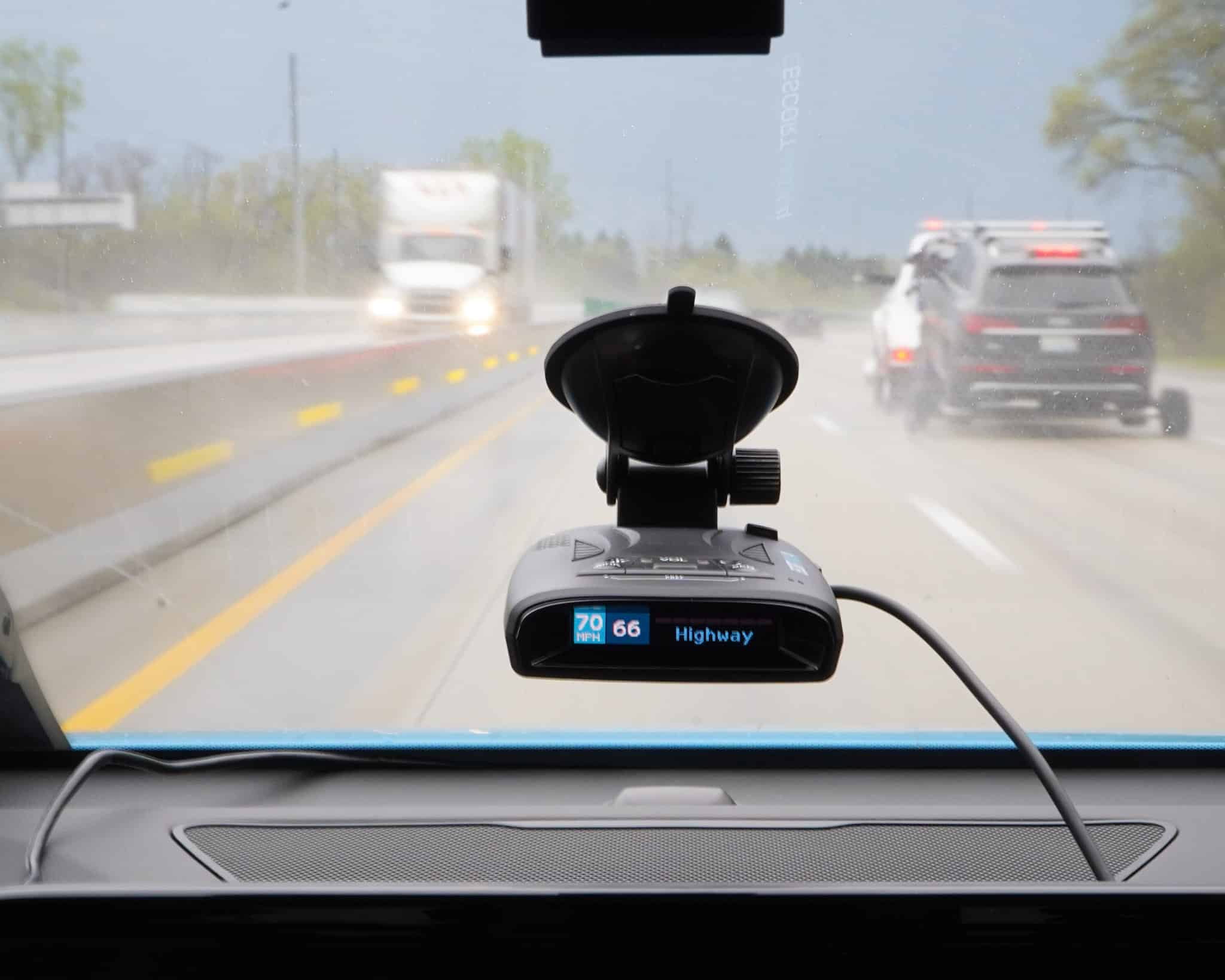
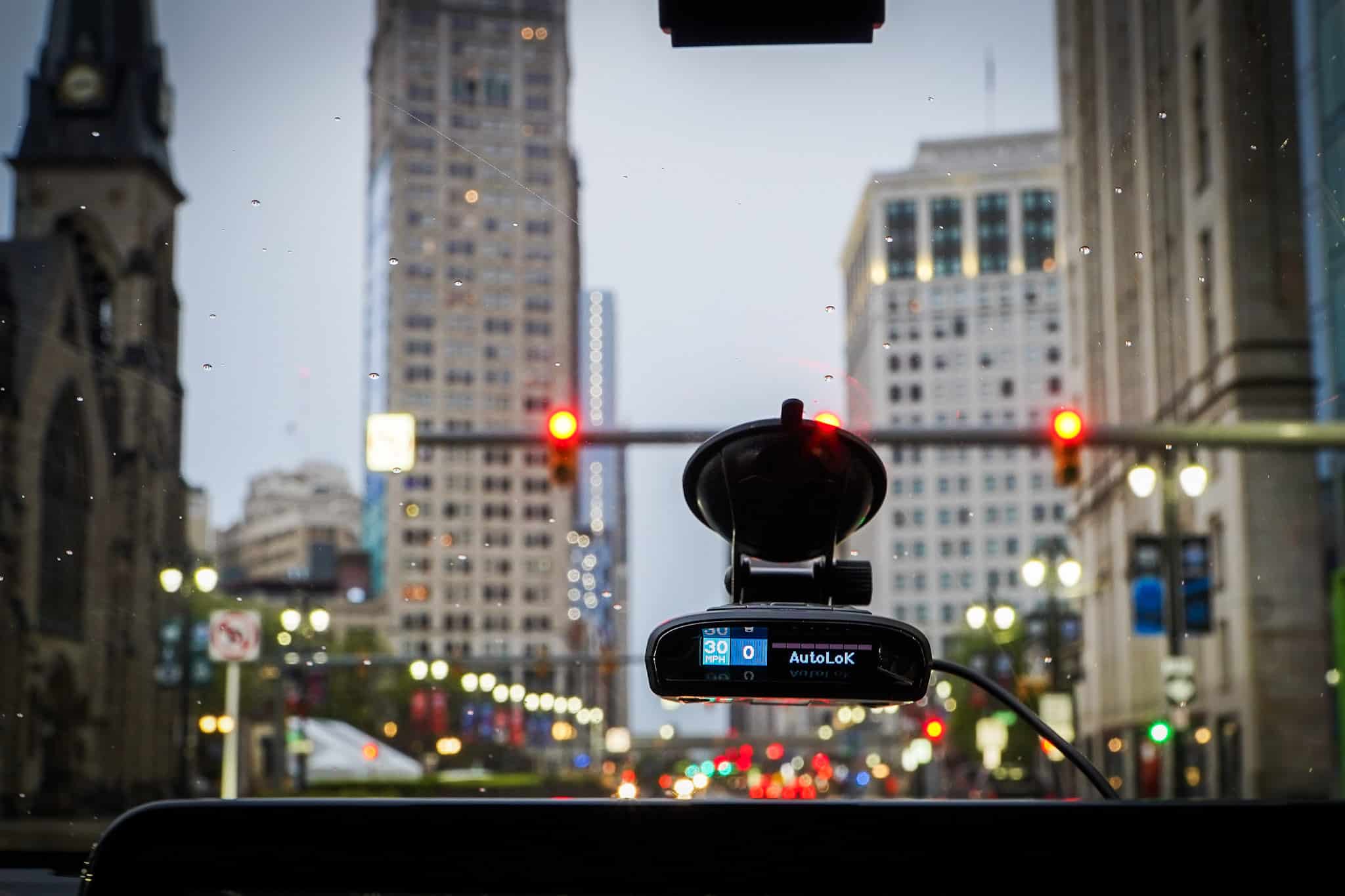
Segmentation Options
Under the “Band Enables” tab in the settings menu or through the Driver Smarter app, you can experiment with four different K Narrow and 10 Ka Narrow segmentation options or “custom sweeps” to dial in the MAX 4’s response time.
Turn either K or Ka Band detection off to activate the segmentation options (done either through the settings menu or the Drive Smarter app). This enables the “selectors,” which you will also see in the settings menu or the Driver Smarter app.
Although it seems counterintuitive, turning off Ka band detection doesn’t mean you are leaving yourself exposed to the most common form of police radar. It simply means you can now work with the segmentation filters.
When we deactivate the Ka bands, Escort’s factory default Ka Narrow settings take over, allowing our MAX 4 to scan from 33.700 to 35.600 GHz. That aligns with law enforcement radar guns, not just here in Michigan, but all properly and legally tuned U.S.-spec police radar guns.
Out of the 10 available Ka Narrow settings, the MAX 4 will have 2, 5, and 8 turned on by default. It breaks down like this:
- KA Narrow 2: 33.700 to 33.900 GHz
- KA Narrow 5: 34.600 to 34.800 GHz
- KA Narrow 8: 35.400 to 36.600 GHz
The idea behind band segmentation is to imagine looking through a row of windows. It takes less time to look through three windows than 10, and the idea here is similar with band segmentation. A radar detector operating in a narrow segmentation versus a wider setting will alert quicker because it’s not scanning or “watching” the entire available frequency range.
AutoLearn Technology (Auto Lockouts)
AutoLearn analyzes fixed-location radar over time to determine whether such alerts are legitimate or false. Should the MAX 4 encounter the exact frequency in the same location approximately three times—and that frequency is deemed false—it automatically locks it out and flashes a “Stored” message. The MAX 4 uses Escort’s TrueLock GPS Filter to lock out and store fixed-location false alerts in its memory bank.
Escort’s AutoLearn feature has become synonymous with its MAX family of radar detectors, and it can be a convenient tool while driving. It’s worth noting, however, that some fixed-location radar sources, like automatic doors, may have some variance. For example, seasonal temperature changes can affect the frequency these radar sources transmit and may impact the AutoLearn feature.
Tap the Mute button on the 12V power cord to manually lock out a false alert. When encountering a previously locked-out location, it will display in gray but not audibly alert.
Mark Locations
The MRK button on top of the unit will flag a location and then notify you the next time you are about to pass it. Unlike the lockouts (manual or automatic), the Mark Location feature is intended for areas with legitimate threats.
When marking a location for the first time with the Escort MAX 4, you can specify what it is, from red light and speed cameras to speed traps. You also have an “other” option to mark a location for another reason.
IVT & K Notch Filters
Escort’s proprietary IVT Filter, or “in-vehicle technology” filter, is built into the MAX 4. The IVT Filter decreases the number of false alerts caused by collision avoidance and adaptive cruise control systems of other vehicles, which are radar-based.
The K Notch filter can be activated in the settings menu for the same reason, reducing false alerts caused by certain cars and their radar-based collision avoidance systems (between the frequency ranges of 24.190 and 24.210 GHz). We have the K Notch filter on here in Detroit.
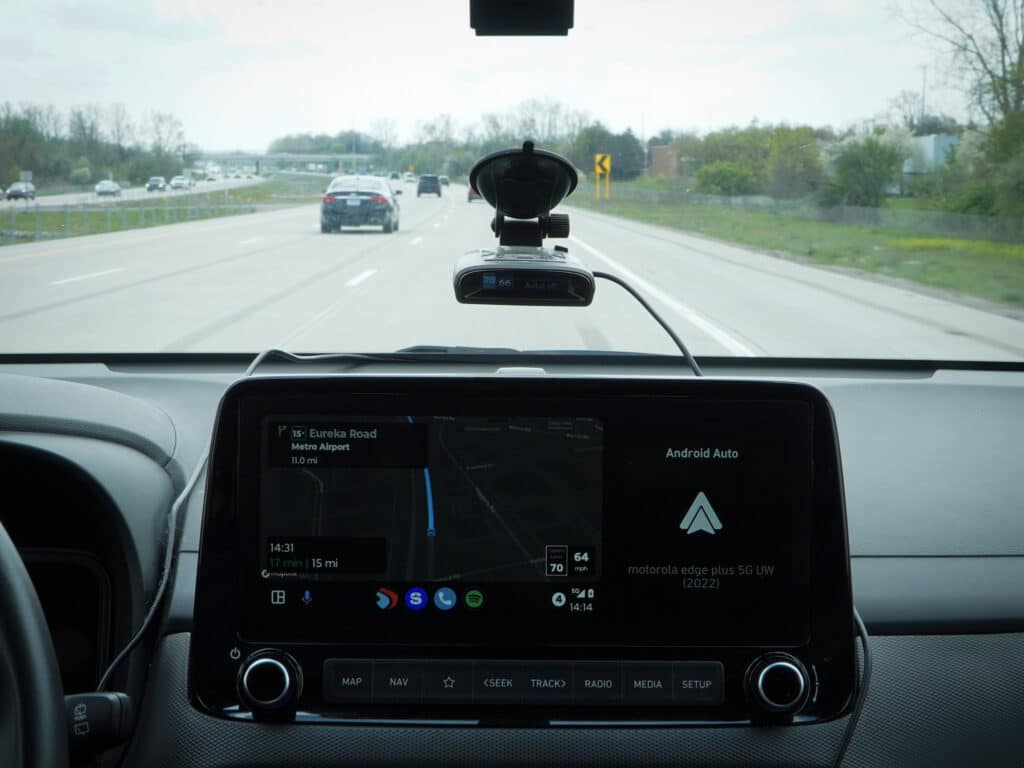
Drive Smarter App
Escort has considerably improved the Drive Smarter app for the MAX family of radar detectors (Drive Smarter is the replacement for Escort Live).
When connected to Drive Smarter, your phone will receive real-time threat notifications in your area, be it a radar source, red light camera, speed camera, or police patrol, as reported by other Escort owners using the app (i.e., shared alerts).
Likewise, you can issue an alert for others via the app if you notice something like a speed trap or stationary patrol car or encounter a speed trap, traffic jam, road construction zone, or other road hazard.
In addition to sending and receiving alerts, Drive Smarter lets you adjust a host of settings for the MAX 4 from your phone, including display colors and brightness, sensitivity modes, and more.
Connectivity & Crashing Issues
In the past, we experienced Bluetooth connection and crashing issues between the app, the detector, and our Motorolla phone with an Android-based operating system. However, Escort has continued to refine its performance, especially for Android operating systems.
Customer Service
While working on this Escort MAX 4 review, we chatted with customer service reps over e-mail from Cedar Electronics (you can contact a support rep through the Drive Smarter app). The reps we exchanged e-mails with about our issues were professional and courteous in each instance.
As of early 2024, all of the connection and crashing issues we had with Drive Smarter have been resolved, including minor glitches like how the speed limit in a given area might display as 74 mph on the app when it’s actually 75 mph.
Even with these fixes and improvements, Escort reps tell us they are continuing to refine the overall performance of the Drive Smarter app for their customers.
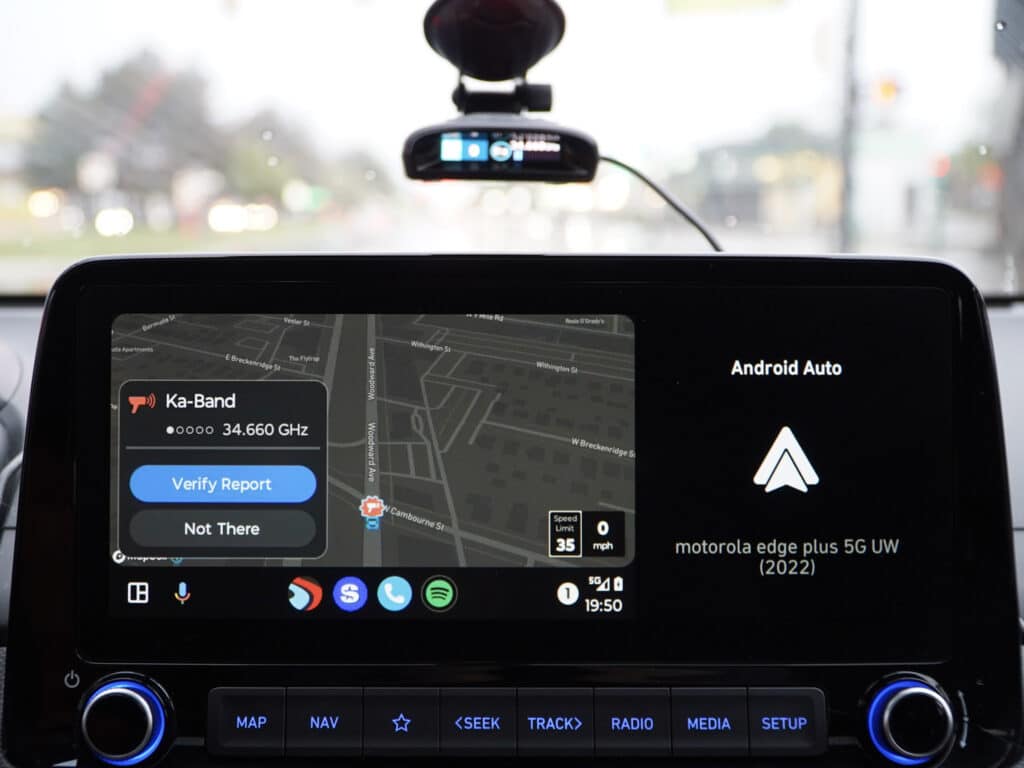
Apple CarPlay, Android Auto & Mapbox
The revised Drive Smarter app is compatible with Apple CarPlay and Android Auto and has Mapbox built-in.
On your vehicle’s touchscreen, you will see all of the normal Apple CarPlay or Android Auto features alongside any real-time threat notifications from Drive Smarter. Similarly, Escort has added Mapbox functionality, meaning Drive Smarter effectively doubles as a navigation app.
While Drive Smarter is optional and not necessary for the MAX 4 to detect police radar, running it can increase situational awareness. When paired with the MAX 4, we found that Drive Smarter, on some occasions, will notify us of police radar sources before the detector issues an alert. This advanced notice is helpful, especially in a busy area with heavy traffic.
If your vehicle has a wireless charging pad, use that to help save your phone battery while running Drive Smarter.
Is The Escort MAX 4 Worth The Money?
The Escort MAX 4 is one of the best radar detectors in the $400 price range. It’s an affordable option that offers good range detection and excellent false alert filtering by combining a pair of Low Noise Amplifiers with a dual-core processor. The Drive Smarter app provides an added layer of security and increases the overall functionality of the Escort MAX 4.
Since the MAX 4 was released in late April 2024, it was not included in our previous roundup of the best radar detectors of 2024, which was published earlier this year. However, that list provides a few other options across all different price points and manufacturers if you are not sold on the MAX 4.
If you decide to purchase a MAX 4, keep an eye on Escort’s website for the latest firmware updates. Likewise, if you get a new MAX 4 and have questions, join us on the forum, and we can point you in the right direction.
Carl Anthony is the Managing Editor of Automoblog and the host of AutoVision News Radio and AutoSens Insights. As a respected automotive industry thought leader, Carl has appeared on numerous podcasts and radio shows, including Wrench Nation, Cars Yeah, The Car Doctor, and Brains Byte Back, in addition to appearing as a regular contributor on MotorMouth Radio on WHPC 90.3 FM. His work can also be seen and heard 24/7 on the Automoblog YouTube channel.
Escort MAX 4 Unboxing Photos
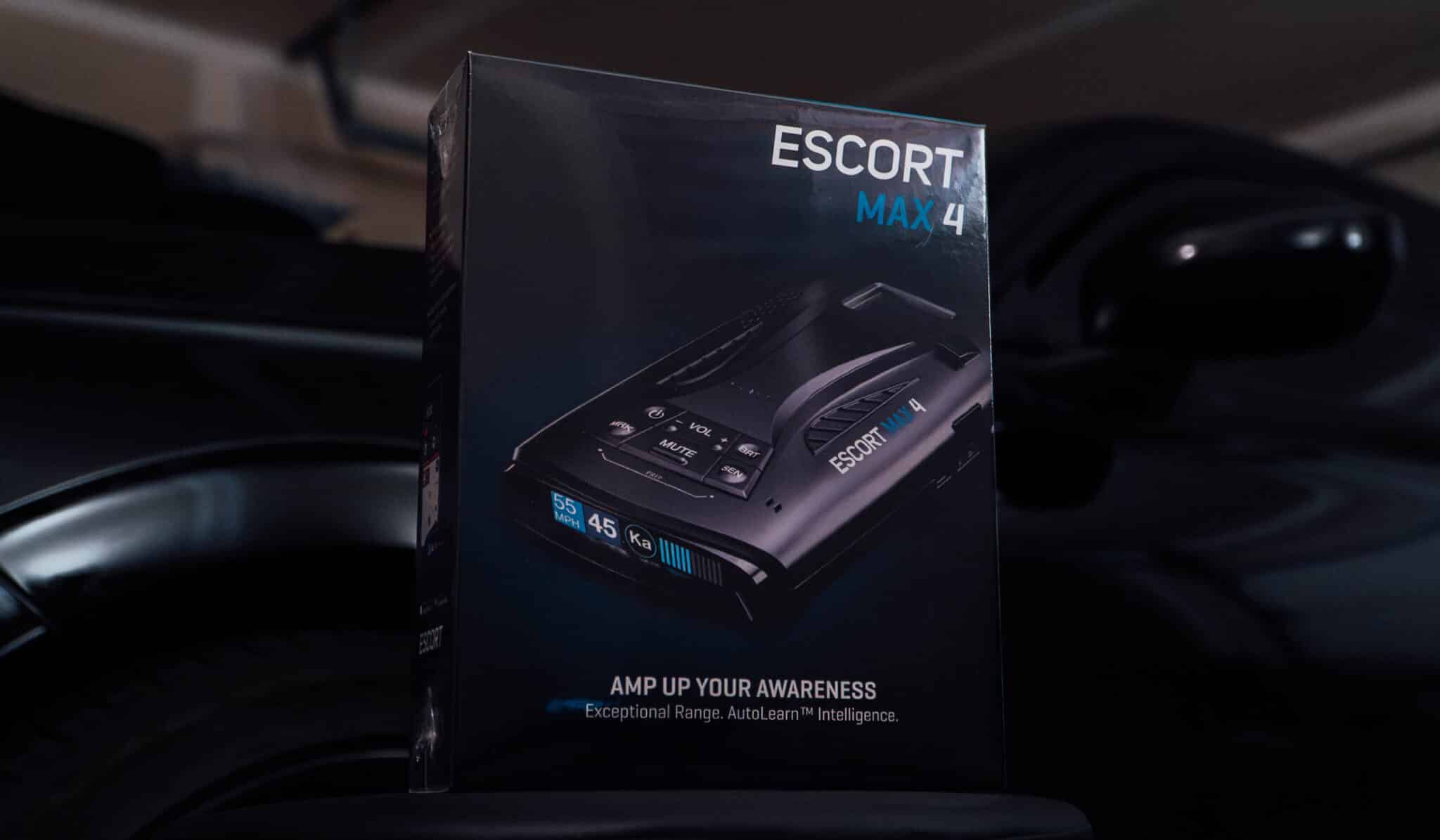
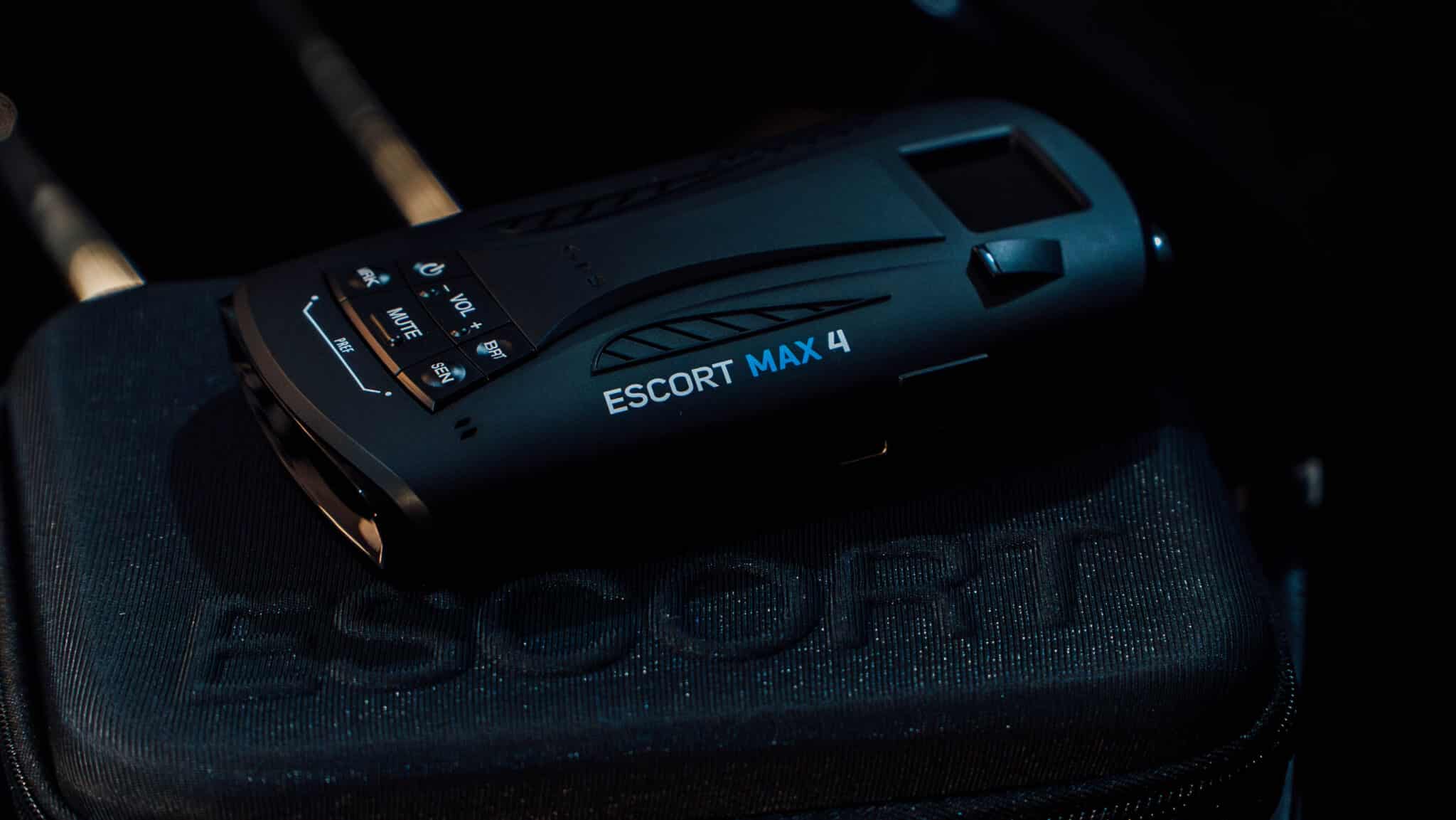
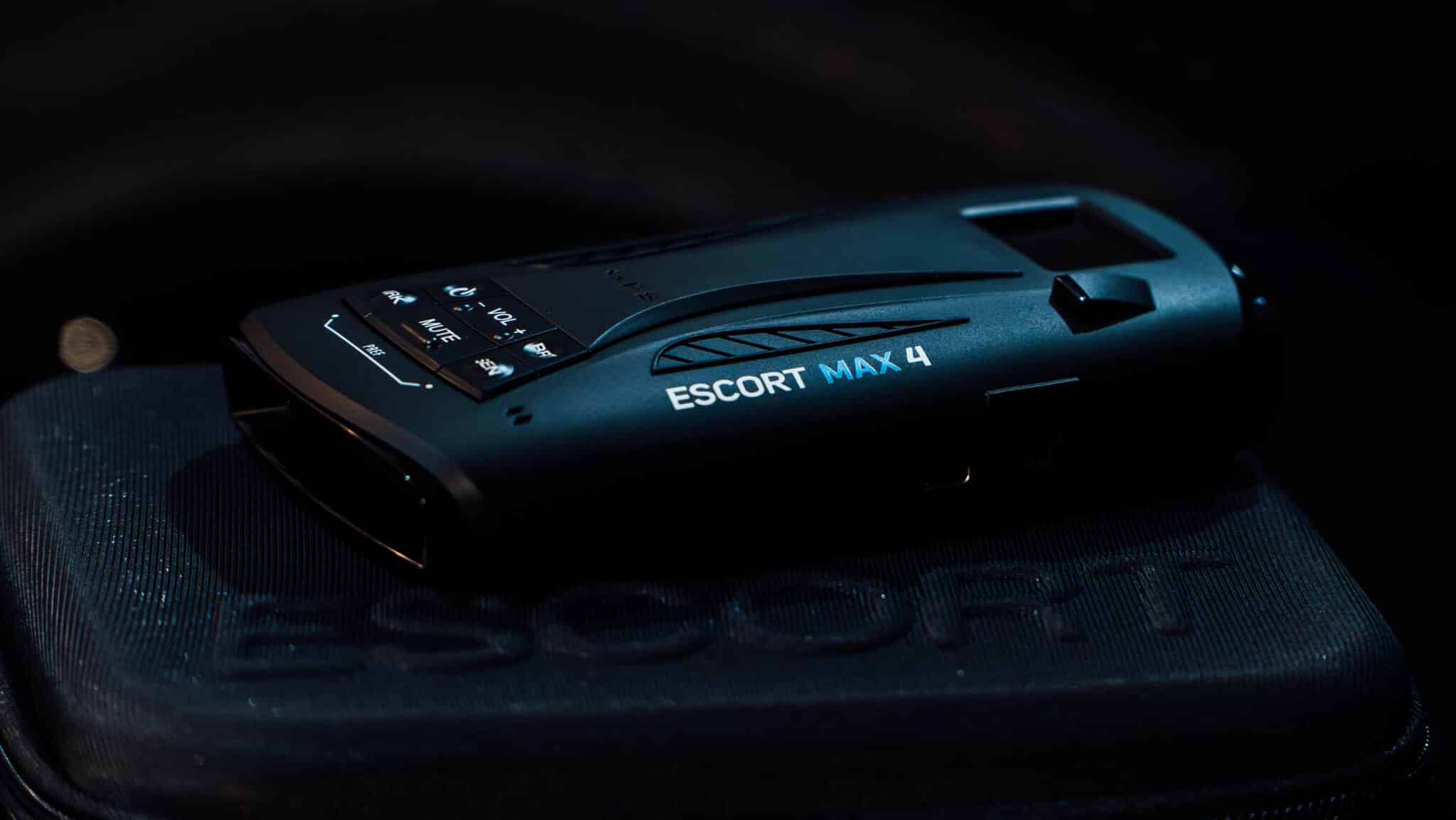
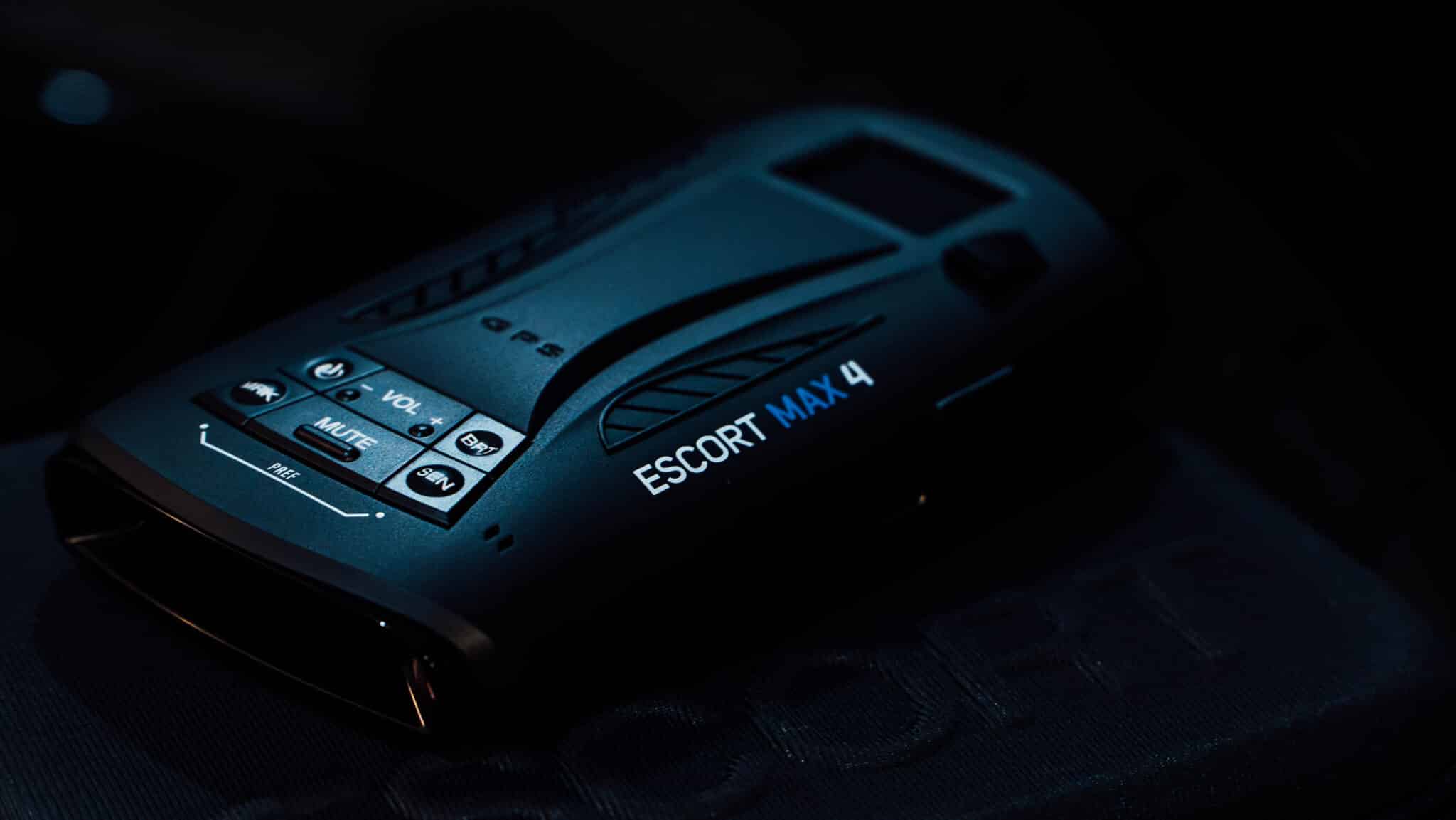
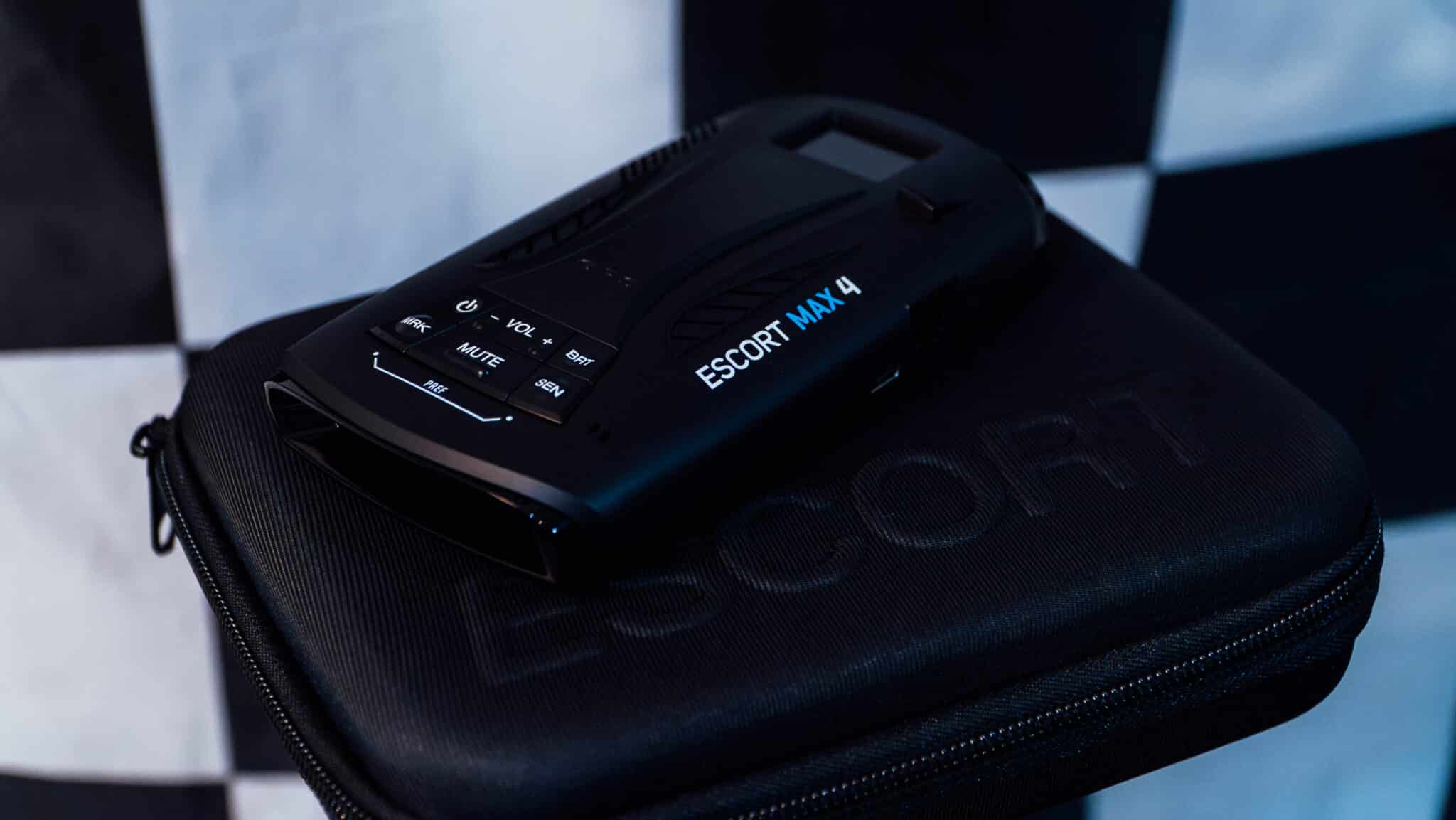
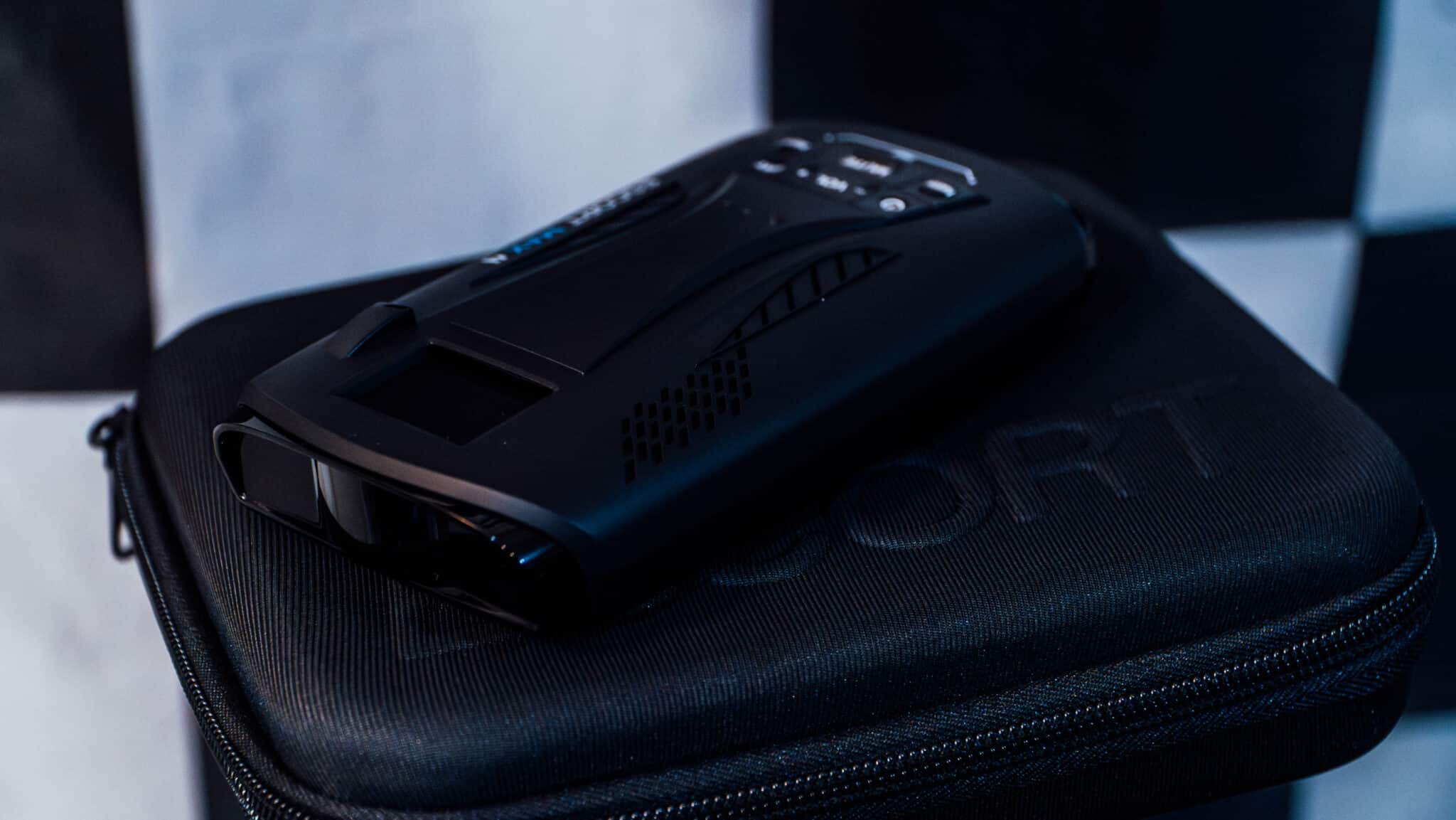
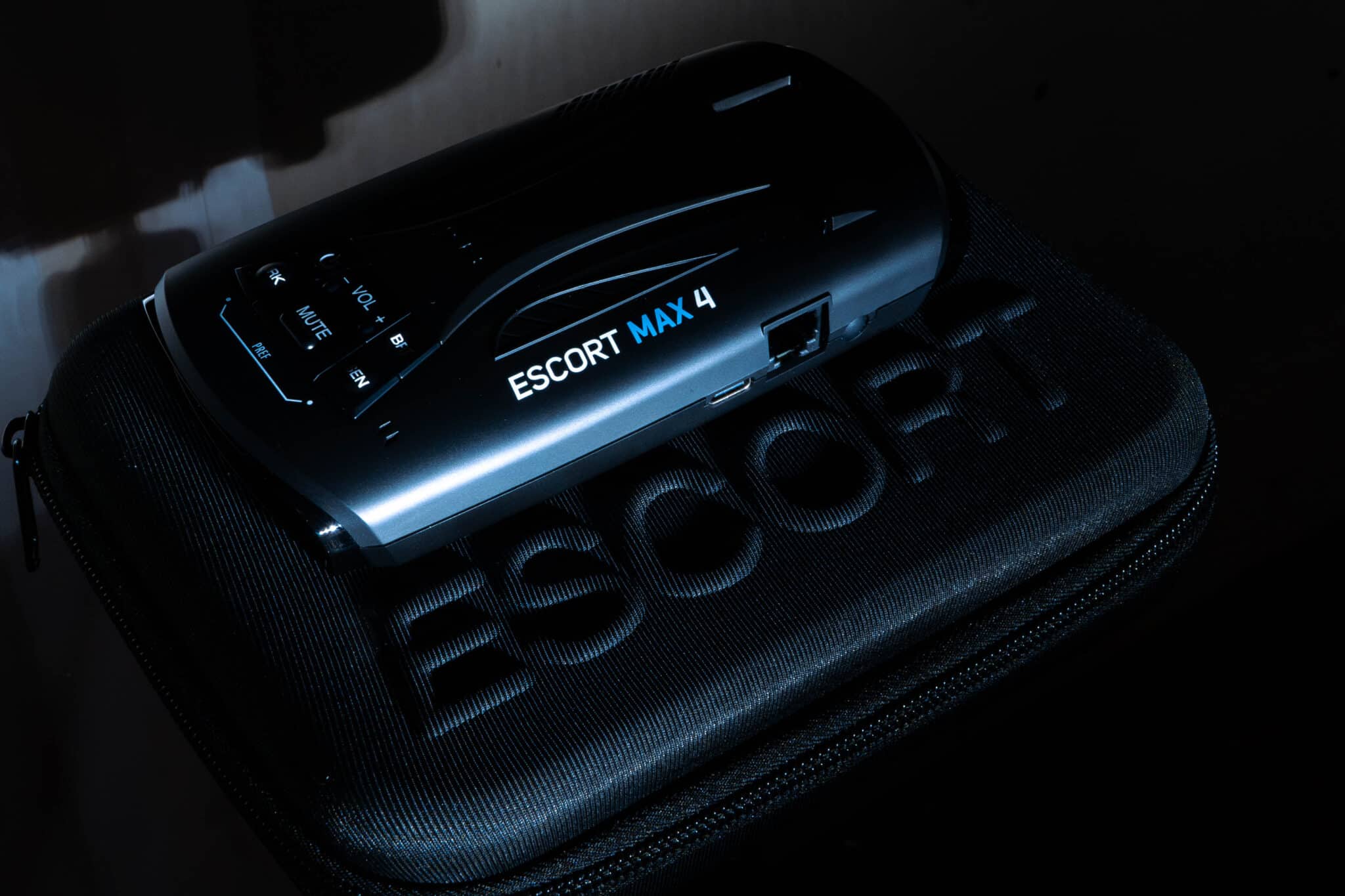
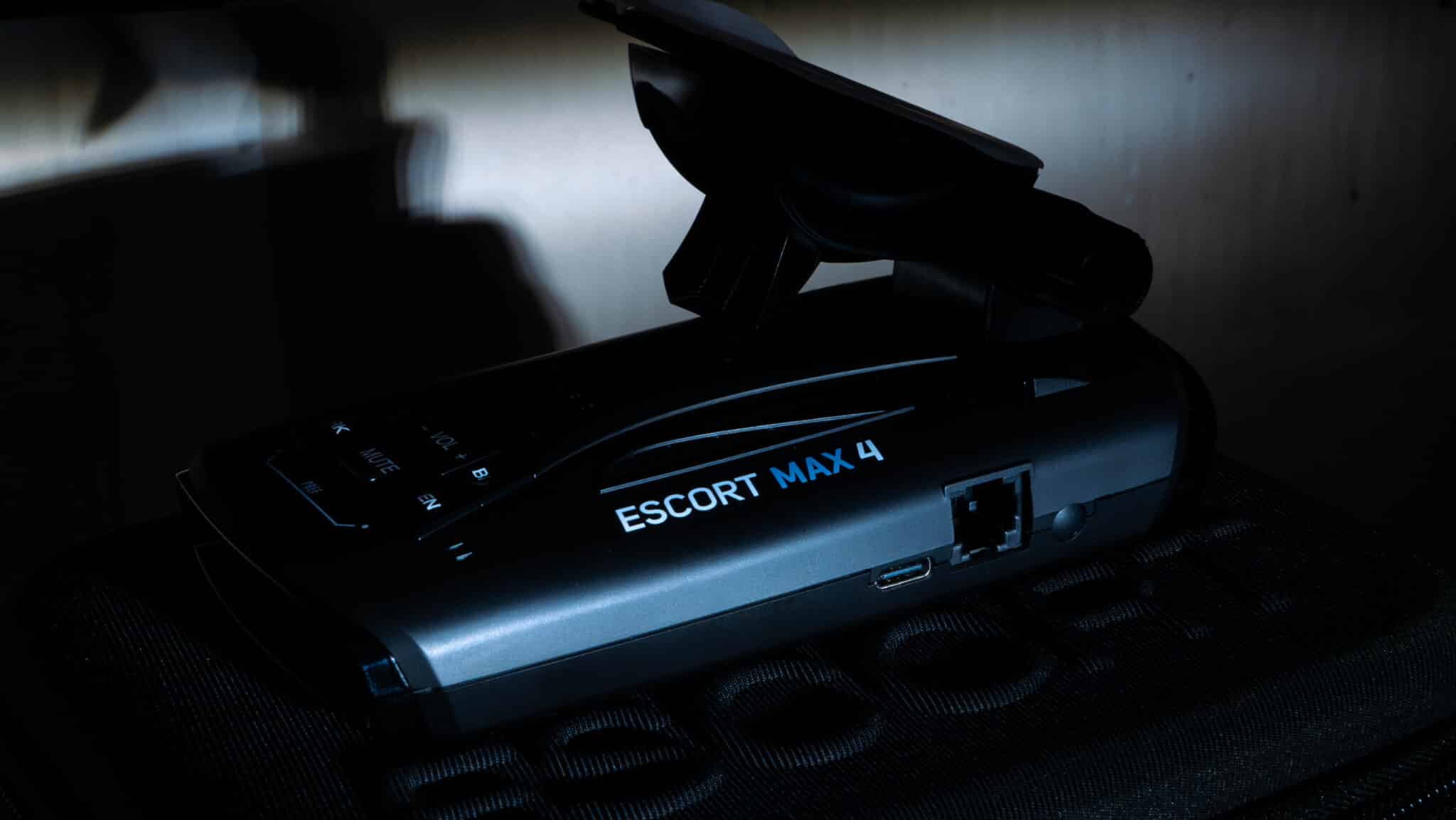
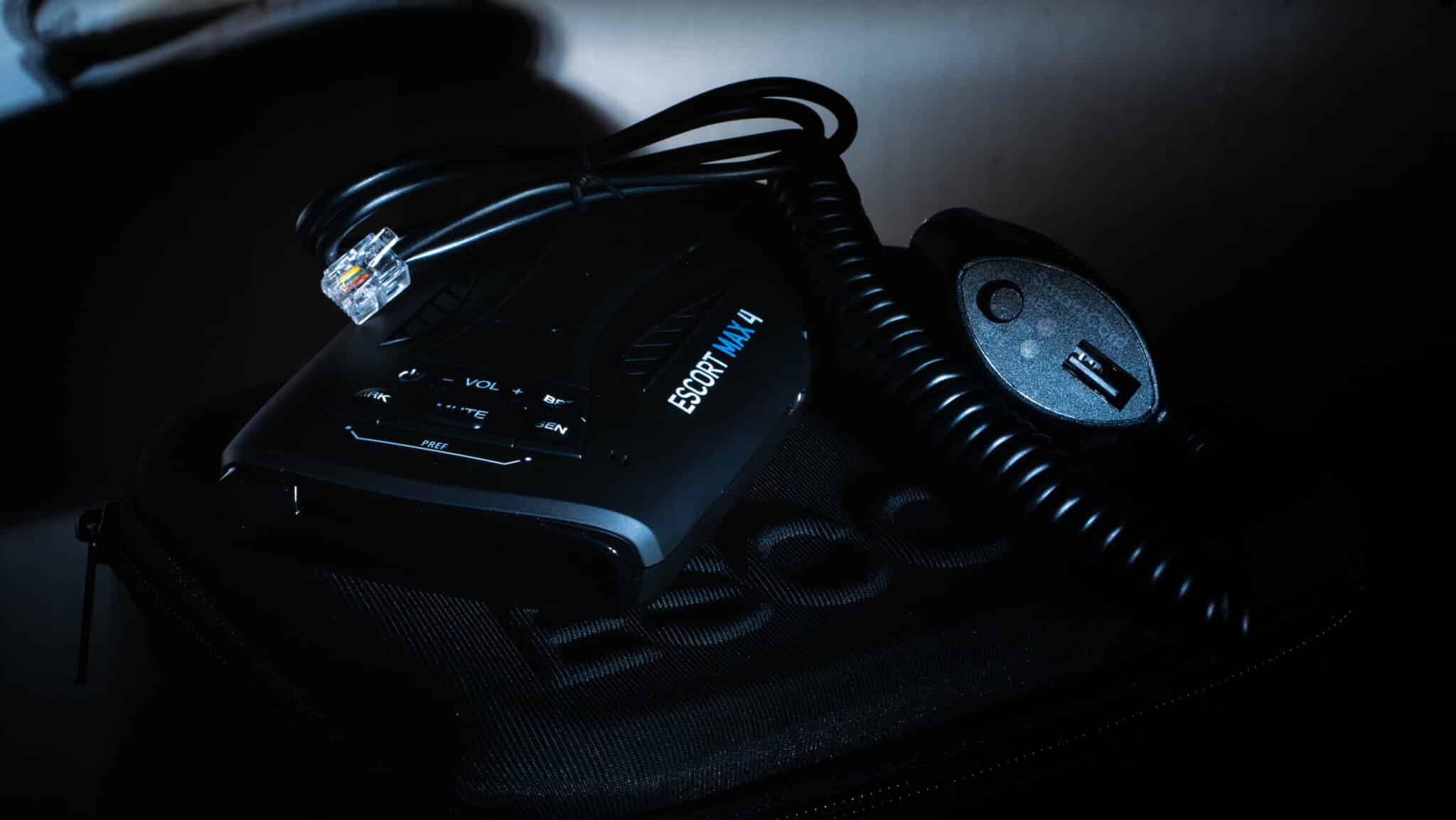
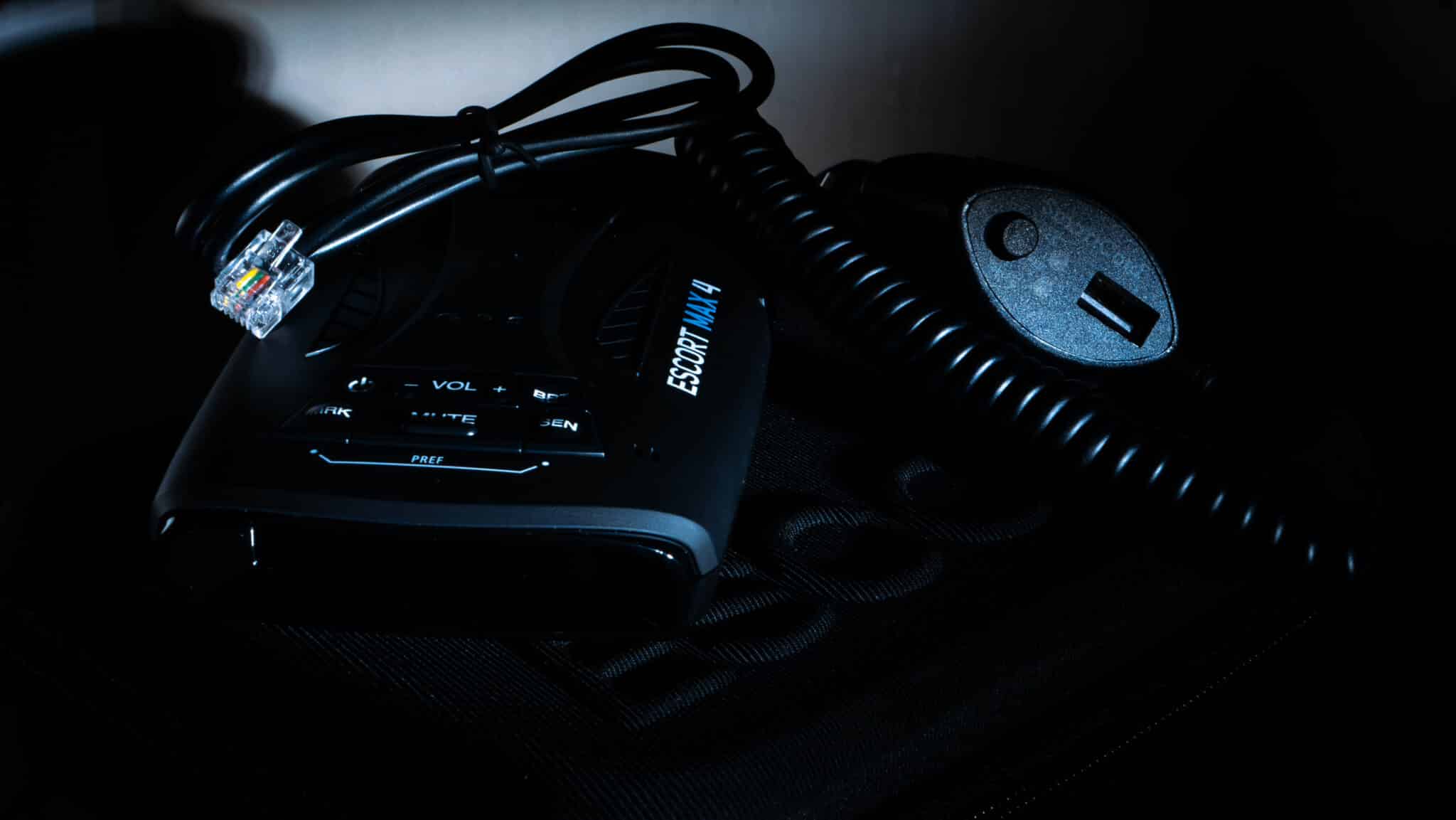
Radar Detectors FAQ
Are Radar Detectors Legal?
Using a radar detector in a privately owned passenger vehicle is legal in the U.S., with the exception of Virginia and Washington D.C. Radar detectors are illegal in commercial vehicles. See this guide to radar detector laws for all 50 U.S. states if you have additional questions.
How Do Radar Detectors Work?
While proprietary technology can differ between each radar detector manufacturer, think of a standard radar detector in terms of receiving and deciphering.
Every radar detector has a “horn” or antenna (sometimes more than one) and an internal microprocessor. The antenna picks up or receives the police radar gun, and the microprocessor deciphers it, ultimately showing on the display screen important info like signal strength and band type.
Radar detector manufacturers build on that basic principle with their own hardware and software to achieve increased detection range with fewer false alerts.
Will My Radar Detector Alert to Laser Guns?
Yes, all radar detectors will alert to police laser guns, meaning your radar detector is also a laser detector by default.
Some radar detectors are compatible with an accessory called laser shifters, but those are different from laser jammers, which are illegal in some states. Police laser guns use a technology called lidar, which stands for light detection and ranging.
What Is The Best Radar Detector For Me?
The best radar detector for you will depend on where and how you drive and how much you want to spend.
If you love having the latest and greatest gadgets, you might enjoy the features a high-end unit will provide. By contrast, if you only need a gentle reminder of police radar in the area, you can find something more basic but still of good quality.
Popular radar detector manufacturers today include Cobra, Escort, Radenso, Uniden, Valentine, and Whistler. Some high-performance radar detectors, like the Escort Redline 360c, are compatible with a smartphone app that shares user-generated alerts.
I Saw a Police Car, Why Didn’t My Radar Detector Alert?
Sometimes, a patrol car will have its radar gun off, meaning there is nothing for the radar detector to alert to. Traffic officers also use an enforcement strategy called “Instant-On” radar, where they only use their radar gun at certain times (think like the storied image of the officer on the motorcycle hiding behind the billboard).
If this happens, traffic officers will only target one vehicle at a time. Most high-quality radar detectors will alert to Instant-On radar with plenty of advanced notice, although it’s still possible to get a ticket via Instant-On if you are not careful.










































